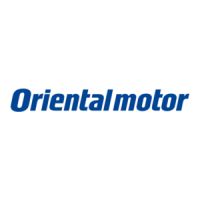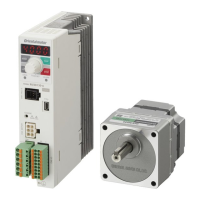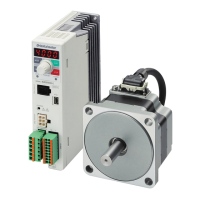Do you have a question about the Oriental motor BLE2D300-C and is the answer not in the manual?
General advice on product usage and safety precautions.
Lists related manuals and how to obtain them for comprehensive information.
Precautions for the operating environment and handling the product.
Safety guidelines for handling the product and its components safely.
Safety precautions related to installing the motor and driver correctly.
Safety measures for connecting cables and components securely.
Safety instructions for operating the motor and driver to prevent hazards.
Safety guidelines for maintenance and inspection procedures.
Warnings against unauthorized repair or modification of components.
Information regarding warning labels attached on the driver.
Guidelines and precautions for wiring connections, including noise elimination.
Precautions for installation, including grease measures and low temperatures.
Precautions and guidelines for operating the motor in various applications.
Warnings about performing tests with connected motor and driver.
Precautions for handling the driver's semiconductor elements and static electricity.
Notes and warnings when saving data to non-volatile memory.
Information about driver specification changes and manual compatibility.
Lists added INFO action parameters due to specification changes.
Overview of setting operation data and parameters using PC software.
How to set operation speed and torque limiting using external devices.
Verification of included items in the package.
Guide to identifying the product model based on its nameplate.
Explanation of the information found on the product's nameplate.
Lists compatible motor and driver combinations.
Detailed description of the names and functions of driver parts.
Requirements for selecting a suitable installation location for the driver.
Methods for installing the driver, including clearances and orientation.
Clearance requirements when installing multiple drivers side by side.
Installation guidelines for drivers mounted in close contact.
Method for installing the driver onto a DIN rail.
Physical dimensions and mass of the driver.
Instructions for connecting the power supply to the driver.
Importance of connecting a circuit breaker for power line protection.
How to connect the motor and driver using connection cables.
Using extension cables to increase wiring distance.
Proper grounding methods for the motor, driver, and cables.
Measures to prevent damage from static electricity.
Connecting input and output signals to the CN5 terminal.
Explanation of the photocoupler input circuits for signals.
How to change logic levels for input signals.
Explanation of photocoupler/open-collector output circuits.
How to change logic levels for output signals.
Connecting external potentiometers or DC voltage for settings.
How to connect the USB cable for PC communication.
Connecting the regeneration resistor for continuous regeneration.
Method for connecting the regeneration resistor.
Technical specifications of the regeneration resistor.
Detailed wiring diagram for connecting components.
Connection example using an external power supply for input signals.
Explanation of source logic for input signal connections.
Examples of I/O signal connections with a programmable controller.
List and description of input and output signals.
Initial display and status upon AC power activation.
Procedure to select local operation mode.
How to change the motor rotation direction using the panel.
Steps to start and stop the motor using the operation panel.
How to adjust the motor speed via the operation panel.
General flow for operating the motor using external signals.
Setting up to 16 operation data points for various settings.
Procedures for setting motor rotation speed using digital or analog methods.
Detailed steps for setting speed with external devices.
How to set the torque limiting value for safe operation.
Setting acceleration/deceleration times to prevent load shock.
Switching between operation and stop using FWD/REV inputs in 2-wire mode.
How to set the motor output shaft and gearhead rotation direction.
Names and functions of parts on the driver's operation panel.
Detailed description of the operation panel components and keys.
Explains how to interpret numbers, alphabets, and signs on the display.
Overview of the four operation modes: Monitor, Data, Parameter, Test.
Details on how to transition between different operation modes.
Details on what information can be monitored from the driver.
How to check and adjust the motor rotation speed.
Function to change rotation speed while the motor is running.
How to check the motor's output torque load factor.
How to check the currently selected operation data number.
How to check, reset, and clear alarm codes and history.
How to check and clear generated information messages.
How to check the status of input/output signals and external voltage.
Step-by-step guide to setting operation data like speed and torque.
Procedures for setting various parameters using IDs and data settings.
How to use test mode to check I/O signals and electromagnetic brake.
Detailed explanation of the I/O test function.
How to perform a test on the electromagnetic brake.
How to enable/disable edit lock to prevent panel operations.
Lists parameters related to basic settings like speed and direction.
Parameter to select command source for speed and torque.
Parameter for setting the speed reduction ratio.
Parameter for setting the speed increasing ratio.
Parameters related to alarm and information settings.
Parameters related to operation modes and filters.
Parameters for I/O signal assignment and logic levels.
Parameters related to operation panel settings and USB interface.
Recommended periodic inspection items for the motor and driver.
Information on how to check the product warranty.
Guidelines for proper disposal of the product.
Common causes and solutions when the motor fails to operate.
Troubleshooting steps when the rotation speed display is abnormal.
Solutions for issues with setting the dial.
Causes and fixes for incorrect motor rotation direction.
Reasons and solutions for inability to increase speed.
Reasons and solutions for inability to decrease speed.
Troubleshooting for unstable motor operation and excessive vibration.
Methods to reset alarms and important notes regarding alarm conditions.
How to check and clear the history of generated alarms.
Lists common alarms, their causes, and remedial actions.
Causes and remedies for main circuit overheat alarm.
Causes and remedies for overvoltage alarm.
Causes and remedies for undervoltage alarm.
Causes and remedies for sensor error alarms.
Causes and remedies for main circuit output errors.
Causes and remedies for overload alarms.
Causes and remedies for overspeed alarms.
Causes and remedies for EEPROM data errors.
Causes and remedies for sensor errors during power-on.
Causes and remedies for prevention of operation at power-on alarm.
Causes and remedies for regeneration resistor overheat alarms.
Causes and remedies for external stop alarms.
Technical specifications for motor models and drivers.
Detailed specs for 30W and 60W motor and driver models.
Detailed specs for 120W and 200W motor and driver models.
Detailed specs for 300W and 400W motor and driver models.
General environmental and operating specifications for the driver.
Pin assignments for driver connectors and cables.
Compliance with UL and CSA standards.
Compliance with EU Low Voltage and EMC Directives.
Compliance with Korean Radio Waves Act.
Compliance with RoHS Directive regarding hazardous substances.
Methods for installing and wiring to meet EMC Directive requirements.
How to install a mains filter to prevent noise propagation.
Using external power supplies and shielded cables for EMC compliance.
Methods for wiring power supply cables, including grounding.
A diagram illustrating compliant installation and wiring practices.
Measures to prevent damage from static electricity during operation.
| Brand | Oriental motor |
|---|---|
| Model | BLE2D300-C |
| Category | Engine |
| Language | English |












